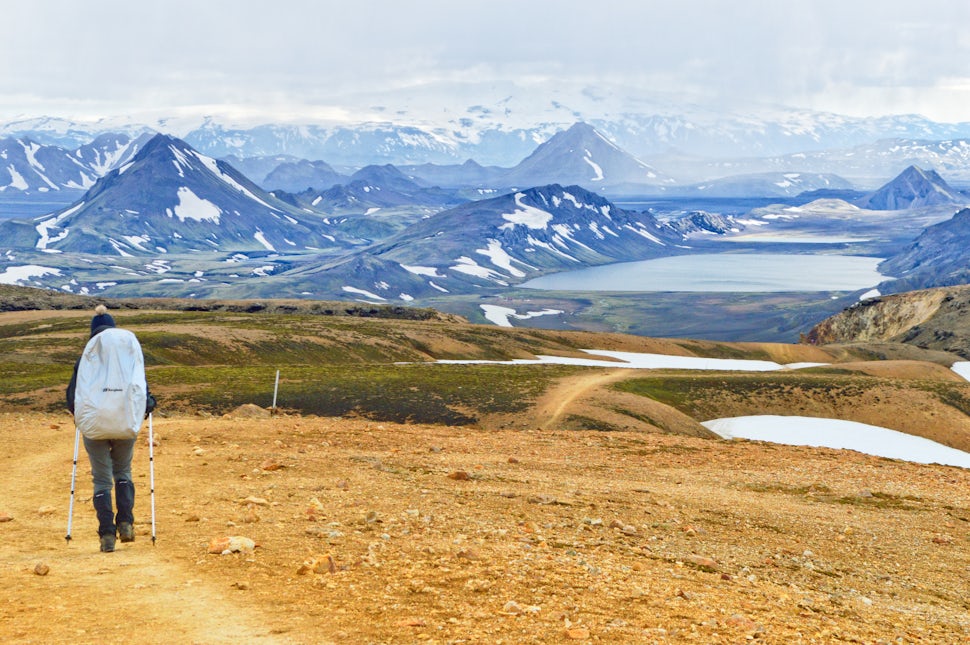7 Lessons I Learned Planning My Backpacking Trip Abroad
Don't head overseas without doing a little research.

When I was planning my first big hike overseas, I found myself bouncing between feelings of excitement and nervousness. Online accounts and photographs of the hike were absolutely stunning, but it’d also be my first solo hiking trip, and it’d be thousands of miles from home. I scoured official national park websites, pack lists, and blogs but still had questions. What did I really need? Should I rent a sleeping bag? Is it worth it to check a bag so I could bring my pocket knife? What if my flight got delayed? After several backpacking trips abroad, here is what I wish I’d known when I was planning and packing for that first trip.
1. Give yourself some wiggle room on flights.
I never thought a big storm in Austin could cause major flight problems a week later until I arrived in the airport to be greeted by announcements of cancellations and delays. My hiking passes were only good for certain days and there were no openings until next season; I had no flexibility in my trek departure date. My flight ended up being delayed, and I was rerouted and nervous. When I finally made it to Auckland I was more than 12 hours late, had missed my connection to Queenstown, and my bag was somewhere between Austin and Sydney. Thankfully the luggage arrived the next day and everything worked out, but without the planned buffer day I would have missed out on a highly anticipated trek.
How to Find the Cheapest Flight Possible | Photo: Brian Fulda
2. You’ll learn more from talking to the locals than you ever would online.
Have you ever read the Lonely Planet article for your own city? Find that it’s missing some of your favorites? Locals are a wealth of knowledge when it comes to their town, and can recommend the gems that aren’t in the guidebooks. As a bonus, you’re more likely to avoid the tourist traps if you’re getting tips from folks who actually live there. There’s so much more to a foreign country than the scenic views, and I guarantee connecting with locals will become one of the more memorable parts of your trip.
Kiwis on my hike informed me that 4 days was way too much time to spend in Queenstown; they graciously invited me to join for a drive across the South Island. Lake Tekapo was on the way.
3. You’ll be able to stow your extra stuff somewhere.
Odds are, you aren’t going be carrying only your backpacking or hiking equipment for an international trip. You’ll have clothes for exploring cities, nicer dinners, and other items to make yourself presentable to the general public when not backpacking. Pack smart, but know that you can most likely stow your things at the hostel, hotel, or home stay in town. Most places will do this for free, but some may charge a small fee. Don’t forget a padlock!

4. There will probably be places to rent equipment.
If backcountry hiking isn’t the only thing on your itinerary, the thought of schlepping around a tent, sleeping bag, and sleeping pad probably isn’t the most appealing. Most towns, even small ones, that are close to popular hiking have gear outfitters that will rent you equipment. Even if it’s not top of the line, it may be better than unnecessarily carrying extra gear around cities and airports. They make liners for sleeping bags if the thought of sharing with strangers gives you the willies.
5. Grocery shopping will take more time.
While it might be obvious to some, in New Zealand granola is called muesli and summer sausage isn’t a thing. In Colombia, canned tuna is considered good backpacking food. I’ve never spent more time feeling clueless in a grocery store than when shopping abroad. Give yourself some extra time to find the food that will work for you, and know even if you are lucky enough to find a large store, they may not have your backpacking staples.
Backpack Torres del Paine’s “O” Circuit | Photo: Ian Glass
6. Learn some basics of the local language.
And/or carry a common phrasebook. Or at least download the offline dictionary of your language app of choice. Even if English is commonly spoken in the larger cities, odds are in the backcountry that it won’t be. It’ll come in handy to be able to confirm you are indeed heading the right direction, especially if you’re traveling alone. And, it’s just plain rude not to try.
More Spanish would have helped me figure out that Estrella de Agua, in the Cocora Valley of Colombia, is really just a house, and the “view panoramica” is much further than a day hike up the trail.
7. You won’t be able to plan every detail before you go.
And you need to be okay with it. It’s part of travel; go in with an open mind and ready to embrace what comes.
Cover photo: Lauren Ellis
We want to acknowledge and thank the past, present, and future generations of all Native Nations and Indigenous Peoples whose ancestral lands we travel, explore, and play on. Always practice Leave No Trace ethics on your adventures and follow local regulations. Please explore responsibly!
Do you love the outdoors?
Yep, us too. That's why we send you the best local adventures, stories, and expert advice, right to your inbox.










